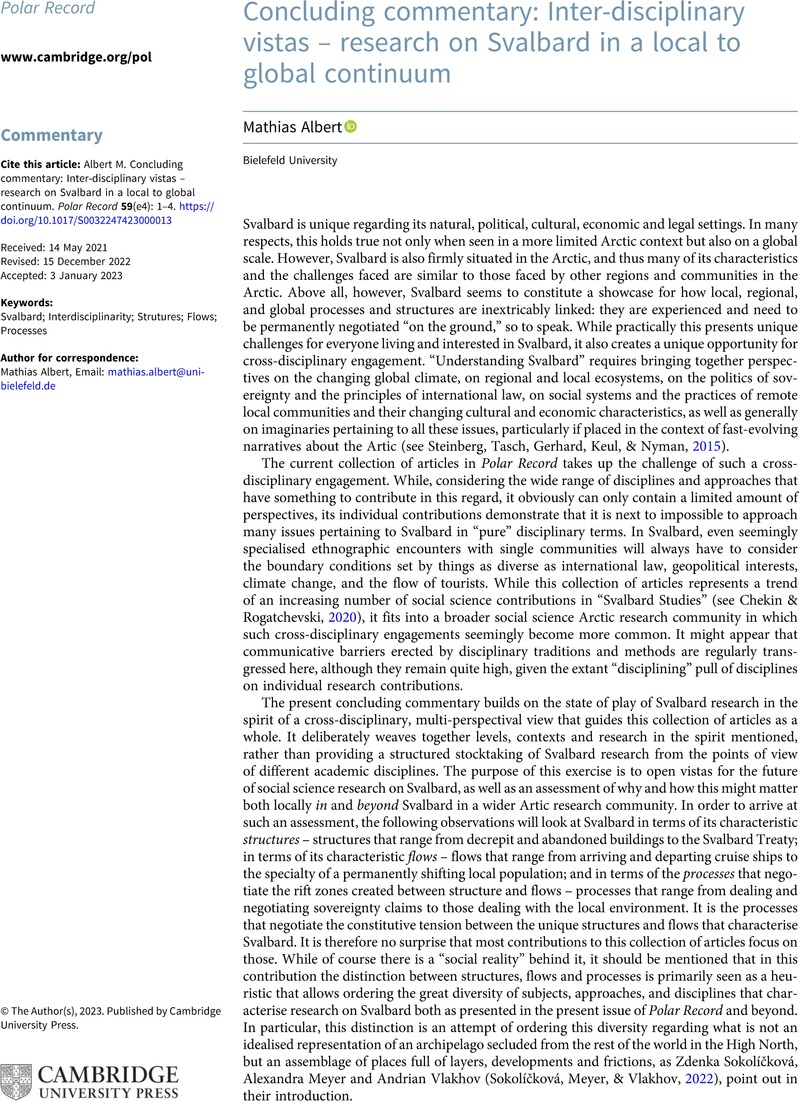No CrossRef data available.
Article contents
Concluding commentary: Inter-disciplinary vistas – research on Svalbard in a local to global continuum
Published online by Cambridge University Press: 30 January 2023
Abstract
An abstract is not available for this content so a preview has been provided. Please use the Get access link above for information on how to access this content.

Information
- Type
- Commentary
- Information
- Copyright
- © The Author(s), 2023. Published by Cambridge University Press
References
Andersen, T. (2022). Negotiating trade-offs between the environment, sustainability and mass tourism amongst guides on Svalbard. Polar Record, 58. doi: 10.1017/S0032247422000080.Google Scholar
Arlov, T.B. (1994). A Short History of Svalbard. Oslo: Norsk Polarinstitutt (2nd ed.).Google Scholar
Avango, D., Hacquebord, L., Aalders, Y., de Haas, H., Gustafsson, U., & Kruse, F. (2011). Between markets and geo-politics: natural resource exploitation on Spitsbergen from 1600 to the present day. Polar Record, 47(1), 2939.Google Scholar
Brode-Roger, D. (2022). The Svalbard Treaty and identity of place: Impacts and implications for Longyearbyen, Svalbard. Polar Record, in press.Google Scholar
Chekin, L. S., & Rogatchevski, A. (editors) (2020). Svalbard Studies (Special Issue of Nordlit, No. 45).Google Scholar
Churchill, R., & Ulfstein, G. (2010). The disputed maritime zones around Svalbard. In Nordquist, M., Moore, J. N., & Heidar, T. H. (Eds.), Changes in the Arctic Environment and the Law of the Sea (pp. 551–593). Leiden: Brill.Google Scholar
Duda, P., Kelman, I., Glick, N., Sokolenko, V., Poussenkova, N., & Nikitina, E. (2022). Disaster risk perceptions and multinational cooperation in Barentsburg, Svalbard. Polar Record, 58. doi: 10.1017/S003224742200002X
Google Scholar
Holtsmark, S. G. (1994). Soviet strategic interests in Norway: Svalbard and the northern borderlands. IFS Info 7/1994 (Norwegian Institute for Defence Studies): 12-16.Google Scholar
Hovelsrud, G., Kaltenborn, B.P., & Olsen, J. (2020). Svalbard in transition: adaptation to cross-scale changes in Longyearbyen. The Polar Journal, 10(2), 420–442.CrossRefGoogle Scholar
Hovelsrud, G., Veland, S., Kaltenborn, B., Olsen, J., & Dannevig, H. (2021). Sustainable Tourism in Svalbard: Balancing economic growth, sustainability, and environmental governance. Polar Record, 57. doi: 10.1017/S0032247421000668
CrossRefGoogle Scholar
Kavan, J., & Halašková, B. (2022). The rise and fall of Pyramiden: The story of a town in a wider geopolitical and environmental context. Polar Record, 58. doi: 10.1017/S0032247422000018
CrossRefGoogle Scholar
Kotašková, E. (2022). From mining tool to tourist attraction: Cultural heritage as a materialised form of transformation in Svalbard society. Polar Record, 58. doi: 10.1017/S0032247422000092
CrossRefGoogle Scholar
La Cour, E. (2022). Geo-Aesthetical Discontent Svalbard, the Guide and Post-Future Essayism. Gothenburg: Göteborgs Universitet.Google Scholar
Meyer, A. (2022). Physical and feasible: Climate change adaptation in Longyearbyen, Svalbard. Polar Record, 58. doi: 10.1017/S0032247422000079
CrossRefGoogle Scholar
Middleton, A. (2022). Norwegian and Russian settlements on Svalbard: Analysis of demographic and socio-economic trends. Polar Record, in press.Google Scholar
Ødegaard, C. V. (2022). Returning to nature. Post-carbon utopias in Svalbard, Norway. Social Analysis: The International Journal of Anthropology, 66(2), 1–22.Google Scholar
Olsen, J., Vlakhov, A., & Wigger, K. (2022). Barentsburg and Longyearbyen in times of socioeconomic transition: Residents’ perceptions of community viability. Polar Record, 58. doi: 10.1017/S0032247422000043
CrossRefGoogle Scholar
Pram Gad, U., & Strandsbjerg, J. (editors) (2019). The Politics of Sustainability in the Arctic. Reconfiguring Identity, Space, and Time. London: Routledge.Google Scholar
Russian Ministry of Foreign Affairs (2020). Letter by the Russian to the Norwegian Minister of Foreign Affairs. https://www.mid.ru/web/guest/maps/no/-/asset_publisher/f4MKo6byouc4/content/id/4019093?p_p_id=101_INSTANCE_f4MKo6byouc4&_101_INSTANCE_f4MKo6byouc4_languageId=en_GB (last accessed 08 December 2020).Google Scholar
Saville, S. (2022). Valuing time: Tourism transitions in Svalbard. Polar Record, 58. doi: 10.1017/S0032247422000055
CrossRefGoogle Scholar
Sokolickova, Z. (2022). The trouble with local community in Longyearbyen, Svalbard: How big politics and lack of fellesskap hinder a not-yet-decided future. Polar Record, 58. doi: 10.1017/S0032247422000286
CrossRefGoogle Scholar
Sokolickova, Z., Meyer, A., & Vlakhov, A. (2022). Changing Svalbard: Tracing interrelated socio-economic and environmental change in remote Arctic settlements. Polar Record, 58. doi: 10.1017/S0032247422000213
CrossRefGoogle Scholar
Steinberg, P. E., Tasch, J., Gerhard, H., Keul, A., & Nyman, E.A. (2015). Contesting the Arctic. Politics and Imaginaries in the Circumpolar North. London: I.B. Tauris.Google Scholar
Ulfstein, G. (1995). The Svalbard Treaty. From terra nullius to Norwegian Sovereignty. Oslo: Scandinavian University Press.Google Scholar
Viken, A. (2008). The Svalbard transit scene. In Bærenholdt, J. O. & Granås, B. (Eds.), Mobility and Place. London: Ashgate: 139154.Google Scholar

